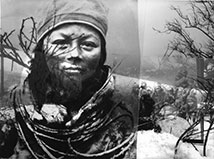| |
 |
| Jorma Puranen: Imaginary Homecoming. Lagešduottar, Norway 1991. |
|
The project
Cultural heritage encompasses all types of things, of all ages. Cultural heritage is a term used for the significant remains, structures, buildings and artefacts that are the result of human activity and whose age varies from prehistoric to modern. Not only art and photographs can be considered cultural heritage, traditions that have been gathered and recordings are, too. Sámi cultural heritage refers to the material related to the culture of the Sámi themselves and that of their ancestors.
Numerous researchers and explorers removed this material cultural heritage from the Sámi region for hundreds of years. Some of this material has ended up in museums and research institutions in the Nordic Countries and Europe. The number of museums and institutions with collections based on the Sámi cultural heritage as well as how large and how these collections even came to be is still open. Sometimes collections and individual artefacts were acquired through trading, but these have also been taken without permission, by forcing someone to relinquish them or through unscientific digs. This was particularly prevalent for artefacts related to practicing the Sámi's ancient religion, as occurred with the shaman drums. These drums were destroyed, confiscated and shipped to museums around Europe. Scientists dug up numerous cemeteries and the bone material was shipped around Europe to research institutions for their collections. In addition, the Lapland War of 1944–45 saw the destruction of material culture in Lapland in both Finland and Norway. Nowadays, the majority of the Sámi cultural heritage that has been put in museums is located in archives and collections outside of the Sámi region, for which reason they are not readily accessible by the Sámi themselves.
The goal of the “Recalling Ancestral Voices” project is to repatriate knowledge of the material culture heritage to the Sámi in the form of a database. The database will contain existing and reviewed information on the collections of Sámi artefacts in the Nordic Countries. Once the database is ready, it will be published on the Internet, which will improve the possibility of learning about this cultural heritage. The database will be translated into the Nordic languages and into several of the Sámi languages spoken in the Nordic Countries. Information will be collected, all the way from prehistoric material to modern times. The information collected is useful for entrepreneurs of traditional and modern businesses, civil servants, Sámi museums and researchers of Sámi culture. The database is also useful for museums and institutions outside the Sámi region that will learn new information about the artefacts in their collections and collection and research history that is behind the collections they have. One objective when entering records into the database is to restore and harmonise terminology that is disappearing so that it would be easier to compare, search for and study artefacts. This occurs by registering the names of the artefacts using the modern orthography according to their background.
|
|

